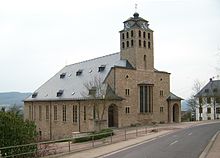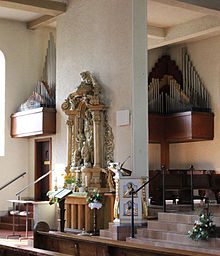St. Martin (Bietzen)
The Church of St. Martin is a Roman Catholic parish church in Bietzen , a district of Merzig , Merzig-Wadern district , Saarland . The church bears the patronage of St. Martin . In the list of monuments of the Saarland the church building is a single monument listed.
history
In the " taxa generalis " a church or chapel is listed for Bietzen in 1330 . In 1527, a document also mentions a chapel or church, but its location cannot be determined. In 1730 a new church was built, which was expanded in 1869. The patronage of St. Martin, which has been documented since 1730, suggests that there was a chapel in Bietzen very early on, as the Martinskirchen are among the oldest Christian shrines in the Diocese of Trier .
Decades of heated discussion preceded the construction of today's church. The pastor Heinesch, who worked from 1835 to 1868 , recognized that the church, built in 1730, was only slightly larger than today's Harlinger Chapel , too small. Under Heinesch's successor, Pastor Matthias Fuhs (1868 to 1889), there was an expansion in 1869. In 1912, pastor Amling (1910 to 1924) first spoke of a new church building, who founded a church building association in 1924 . After the introduction of Pastor Michael Jäger (1924 to 1954), he immediately made himself an advocate for a new building, and on August 24, 1924, the church council decided to build a new church in the parish garden. But it was still a few years before the resolution could be implemented, as the mood in the parish changed again in favor of a renovation of the old, ailing church in the center of the village. The Vicariate General also followed this mood . But Pastor Jäger did not allow himself to be dissuaded from his plan, and on February 20, 1930, the church council finally made the final decision to build a new church in the parish garden. The vote on this was very close with 4 to 3 votes.
Architect Peter Marx ( Trier ) was commissioned with the planning and construction management . The foundation stone was laid on the first Sunday in May 1931 . According to the building description , 778 bank spaces were planned and the enclosed space was specified as 7,300 cubic meters. The estimate of the construction cost without the existing interior was 930,000 frcs . The building material , u. a. Quarry stones from the Bietzerberg were brought to the construction site free of charge by the parishioners. On July 16, 1933, the church council and the parish council accepted the accounting , which amounted to 946,895 francs. Earlier, on 18 December 1932 was blessing takes place, and the completed church building was handed over to the church. The consecration was carried out on October 17, 1933 by the Trier auxiliary bishop Antonius Mönch .
Furnishing
The high altar of the church is a baroque columned altar, which is largely in its original condition from 1731. According to the diocese conservator Dr. Busse the altar probably comes from a workshop of the Premonstratensian monasteries , as indicated by the statue of St. Norbert on the altar. On the opposite side is the statue of St. Augustine .
The two wooden side altars were designed by the Mainz architects Ludwig Becker and Anton Falkowski based on the high altar and executed by the wood sculptor Reichmann ( Paderborn ) between 1918 and 1924. The Lady altar with wooden relief showing the Queen of Heaven , the baby Jesus on the hands-supporting and four figures before representing humanity. The Joseph altar shows a large figure of Christ's foster father and the baby Jesus.
organ
The organ of the church, a work of the organ building company Klais ( Bonn ), dates from 1936 and is largely in its original condition. The Kegelladen instrument has 15 (17) registers , divided into two manuals and a pedal . The game and stop action is electro-pneumatic. It has the following disposition:
|
|
|
||||||||||||||||||||||||||||||||||||||||||||||||||||||||||||
-
Pairing :
- Normal coupling: II / I, I / P, II / P
- Sub-octave coupling: II / I, II / II
Bells
The St. Martins Church has a four-part bell. Bell 3 is from the interwar period. In 1955, the Saarlouis bell foundry in Saarlouis-Fraulautern, which had been founded by Karl (III) Otto from the Otto bell foundry in Bremen-Hemelingen and Alois Riewer from Saarland in 1953, cast three new bronze bells for St. Martin.
| No. | Surname | Casting year | Weight (kg) | Chime | foundry |
|---|---|---|---|---|---|
| 1 | Christ the King | 1955 | 800 | f sharp | Otto ( Saarlouis ) |
| 2 | Mary Queen | 1955 | 600 | g sharp | Otto (Saarlouis) |
| 3 | St. Martin | 1924 | 359 | H | Mabilon ( Saarburg ) |
| 4th | St. Michael | 1955 | 250 | cis | Otto (Saarlouis) |
Web links
Individual evidence
- ↑ List of monuments of the Saarland, partial list of monuments in the district of Merzig-Wadern (PDF; 320 kB), accessed on May 15, 2013
- ↑ a b c d e 75 years parish church of St. Martin Information about the church on the website of the parish of St. Martin Bietzen , accessed on May 15, 2013
- ↑ The organ on organ index
- ^ Gerhard Reinhold: Otto bells - family and company history of the bell foundry dynasty Otto . Self-published, Essen 2019, ISBN 978-3-00-063109-2 , p. 588, here in particular pp. 87 to 95, 567 .
- ↑ Gerhard Reinhold: Church bells - Christian world cultural heritage, illustrated using the example of the bell founder Otto, Hemelingen / Bremen . Nijmegen / NL 2019, p. 556, here in particular pp. 105 to 112, 518 , urn : nbn: nl: ui: 22-2066 / 204770 (dissertation at Radboud Universiteit Nijmegen).
Coordinates: 49 ° 24 ′ 46.6 " N , 6 ° 39 ′ 32.7" E


